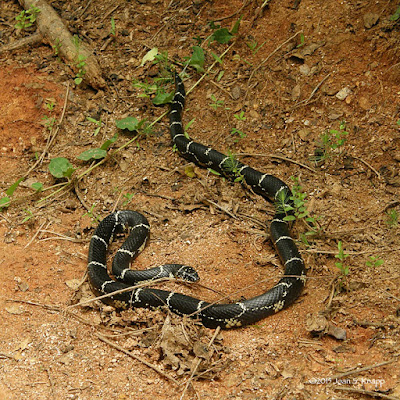June 12th. I was on the final leg of the trail from the
Section B parking lot to the dam at Fort Yargo State Park. This year, I’d met
two snakes – Black Rat Snakes (Elaphe obsoleta) – along this section of the
trail. So I’m always on the lookout for snakes along this section of the trail
where there are woods to the east and the open area to the west is covered with
Kudzu vines.
I’d completed the first flat section of trail and was just
starting down the hill to the final flat section of trail when I saw it… A big snake…
Immediately recognizable as an Eastern Kingsnake
(Lampropeltis getula getula) or Chain Kingsnake, a black snake that has thin
white bands. It was about four feet long. At first, it didn’t look like it was
moving but then it became apparent that it was moving very slowly. It seem
oblivious to the fact that I was standing only about two to three feet from it.
It was poking its nose into the soft surface of the gravel-clay
soil as if it was looking for food.
It didn’t seem to be sensing with its tongue, but it
definitely was...
It almost looked as if it was ‘mouthing’ the soil as it went.
Finally, it had apparently exhausted its interest in this
area and slithered effortlessly up the almost vertical embankment before disappearing
into the woods. This encounter seemed to take forever but, according to my
camera, was only three to four minutes long.
Eastern Kingsnakes are constrictors; they eat snakes
including venomous snakes such as Copperheads (Agkistrodon contortrix), skinks, reptile eggs,
rodents, birds and their eggs, and frogs. I couldn’t find any reference to this
snake eatings insects but I did find a reference to the Eastern Black Kingsnake
(Lampropeltis getula nigra) eating insects. I’m assuming that this subspecies
would also eat insects and that this snake was looking for a snack.
Related post:














No comments:
Post a Comment